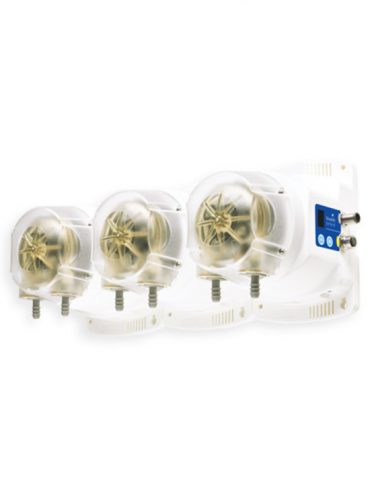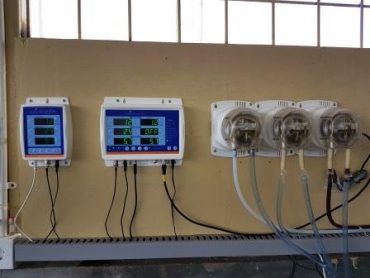Bluelab Peristaltic Dosing Pumps
The Bluelab PeriPod Perstaltic Pumps are a reliable, accurate and safe method of dosing nutrient and pH stock solutions into a hydroponic mixing tank.
They overcome all the shortfalls and dangers associated with using solenoid dosing valves.
The spinning rotors on the front of a peristaltic pump motor compresses the pharmaceutical grade dosing tube and creates a suction. This lifts the stock solutions out of the nutrient and acid stock tanks and allows them to be pumped or gravity fed into the hydroponic mixing tank.
The duration of the dosing cycle is determined by the setpoints programmed into the automatic dosing controller, which the peristaltic pumps are connected to.
Bluelab makes 3 sizes of Peristaltic pump to suit most requirements.
Bluelab M3 Triple Peristaltic Pump – 3 x 120ml per minute pumps NZ$1,652.00
Bluelab M4 Triple Peristaltic Pump – 4 x 120ml per minute pumps (1 for pH Corrector, 3 for Nutrients) NZ$2,253.00
Bluelab L3 Triple Peristaltic Pump – 3 x 1200ml per minute pumps NZ$4,056.50
Selecting nutrient / pH dosing pump sizes
Selecting an appropriate size for a nutrient/pH dosing system is not always simple. Larger pumps are more expensive, but smaller ones may be worked too hard, and fail prematurely – a false economy long term.
Please read the discussion below to understand how other factors impact on your decision.
NOTE: Although reservoir sizes are commonly used to guide pump size choice, it is the actual nutrient uptake/requirement of the crop that determines what the pump system has to deliver. Some crops (leafy greens, for example) require relatively modest nutrient levels, whereas a mature, heavily fruiting tomato crop can have extremely high nutrient demands – even if the reservoirs are the same size.
Bluelab® Peripod™ Pump Selection Guide
- Nutrient uptake/requirement of the crop determines what the pump system has to deliver. Leafy greens, for example, require relatively modest nutrient levels, whereas a mature, heavily fruiting tomato crop can have extremely high nutrient demands – even if the reservoirs are the same size.
- The type of crop, and the number of plants within it are the major determinants of nutrient use, and should be used to determine the pump sizing.
- If the grower anticipates they will grow their operation, L3 may be more appropriate if they fall in the overlap between the two systems
For recirculating and drain-to-waste/batch-dosing systems: |
|||
Bluelab® PeriPod™ M3 |
Bluelab® PeriPod™ L3 |
||
| Total volume of nutrient stock (ECA + ECB) used daily* | 0 – 18 Litres 0 – 4.8 Gallons |
5 – 180 Litres 1.3 – 47.5 Gallons |
|
| 0 – 18 Litres 0 – 4.8 Gallons |
5 – 180 Litres 1.3 – 47.5 Gallons |
||
| OR | |||
| Number of plants fed from reservoir | Heavily fruiting crop e.g. tomato | 0 – 900 Plants | 250 –9,000^ Plants |
| Leafy greens | 0 – 9,000 Plants | 2,500 – 90,000 Plants | |
| There is considerable overlap between M3 and L3 minimum. L3 can be used in smaller systems by using shorter on-times. * If known, use volume of nutrient stock over number of plants to determine the pump sizing ^ Based on 4 sqft/0.4sqm per tomato plant, 5,000 tomatoes is a ~0.5acre/2000sqm facility |
|||
Points to consider when selecting a pump system are:
The type of crop and the number of plants within it are the major determinants of nutrient use.
Most crops have very different nutrient needs during their life cycle, requiring comparatively little at the newly planted out stage, and a vastly greater demand when mature and fruiting/flowering. The period of maximum demand should be what is considered when selecting the pump system.
In recirculating systems, like flood and drain, NFT, aeroponics etc., the pumps usually only need to replace the nutrient used by the crop in the growing system. Often, the reservoir is dosed manually to the correct levels when solution is initially made or replaced, and the dosing system only maintains the levels as the crop removes nutrients and changes pH levels. This may allow a smaller pump system to be used.
Nutrient demands also usually peak during the brighter, warmer part of the day, so the pump size needs to be able to accommodate the period of maximum daily demand. Looking at the 24 hour nutrient usage only, without understanding that 80% of this may need to be delivered in 4 hours during the brighter warmer part of the day, may result in smaller pumps being chosen, and then struggling to maintain the required levels in the middle of the day.
In some batch systems, or in drip to waste systems, the needs are different. A set quantity of nutrient may need to be made up quickly, before the next feed out. This may require larger pumps, which can deliver nutrient at a much faster rate, using larger dosing times, and minimum off times, but still sufficient to allow good mixing between doses. The determining factors here are the quantity of nutrient required, and the speed with which it must be ready. The speed needed to dose up the reservoir may dictate that larger pumps are used.
Another factor to consider is the nutrient stock solution strength. Commercial nutrient stock solutions are often made to roughly 1 part of each stock solution to 100 parts nutrient solution. Therefore, if 1000 litres of nutrient solution is required, then approximately 10 litres of stock solution needs to be pumped from each pump into the reservoir, so the pump size requirement can be determined from this. If other stock solution concentrations are to be used, the required quantities will need to be worked out, and pump requirements adjusted accordingly.
pH may need to be adjusted more when batch dosing, especially if the water supply contains a lot of dissolved minerals. A large initial adjustment may be required, rather than minor plant-induced shifts. Generally, if the nutrient pumps and the pH pumps are the same size, there won’t be a capacity problem. pH adjuster can be diluted down to very low levels to accommodate a larger pump size, if necessary, and 5 – 10% solution (for example) is much safer to handle and store than more concentrated acids, and much less damaging to pump tubing.
If you have experience with the intended crop, crop size and growing system, and familiar with how much nutrient is routinely required then this can be used to decide on the pump system size.
Bluelab® PeriPods™ can be daisy-chained.
So another can be added if your system is expanded, or if a crop with higher demands is grown. Remember that it is always better to have a larger pump system dosing for shorter times, than to have smaller pumps working near the limits of their output. pH adjuster can be diluted as much as required to allow a larger pump to not overshoot, and dosing on times can be reduced to as little as a second.
If in doubt, get a larger system.



